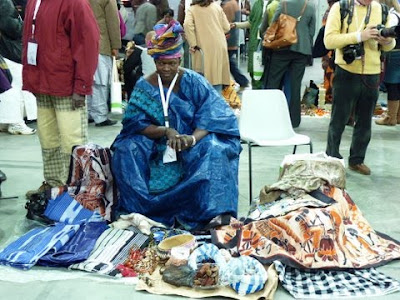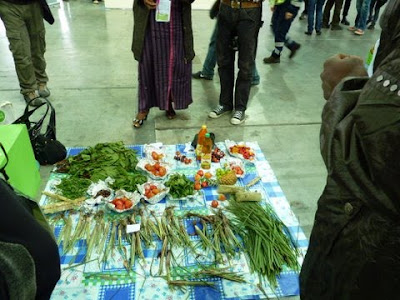Most of us who were attending Terra Madre for the first time, really had no idea what we were in for.
Safeguarding food biodiversity for the future is one of the fundamental principles of the Slow Food association and the entire Terra Madre network is engaged in defending local food and outstanding products that are perfectly integrated with the geographical, climactic, cultural and traditional characteristics of a place. Terra Madre 2010 focused on cultural and linguistic diversities - in recognition of the need to defend minority ethnic groups and indigenous languages, with an appreciation of the value of oral traditions and memory. At the opening ceremony, that you read about in the glimpses post, representatives of indigenous communities from the 5 continents addressed the audience in their native languages.
The second day of the Terra Madre conference was dedicated to examining eight crucial issues for the future of agriculture and the planet (from biodiversity to renewable energies and education to traditional knowledge). But even before we got to the conference we entered the Oval Lingotto into a space that brought together a world under one roof. Representatives from the Earth Markets and all the Slow Food Presidia, including those who did not have a stand at the Salone del Gusto, for various reasons (such as their product not being available) were gathered here. At the Oval, one room was dedicated to presenting the network’s projects to safeguard biodiversity and promote food and taste education. The Slow Food projects room gave delegates the opportunity to learn about current activities in over 150 countries around the world and at the same time report on the initiatives in which they were involved. The Slow Food projects room will also host several conferences open to Terra Madre visitors and specifically linked to biodiversity protection issues:
Within the Oval, interactive educational activities on biodiversity were be open to all Terra Madre visitors offering a better understanding of terms such as “native varieties and breeds” and “traditional techniques”. through pictures, games, quizzes and tastings. The first thing I happened to walk over to was a section dedicated to plant varieties. The display was extremely graphic, on one side was a display of the five varieties most commonly available on supermarket shelves around the world. On the other side were a hundred apples of different shapes and colors some of which were close to extinction. The message in the display was a representation of the different cultures and flavors and how this irreplaceable genetic heritage is the result of the slow adaptation of varieties to a specific place.
And then I walked onto the market space of Terra Madre, where people from indiginous origins had set up a sort of impropmtu flea market. I had my first goose bump inducing moment then, because it came home to me that never before had I been under the same roof with thousands of people, each with a different skin color, costume, religion, culture, beliefs and even cuisine. We all came from the same roots, TERRA MADRE or Mother Earth! And like those 100 diverse apples that had evolved to suit the conditions they had to grow in, we had all evolved to suit the conditions we had to exist in! It was both humbling and exciting. And for me personally, having always worked to blend in, fit in, not call attention to oneself, I was more than a littel proud to be a part of a forum where you were honoured for being brave enough to wear your color, costume and individuality with pride.
I will let the pictures speak for themselves now!
 |
| 5 Apples |
 |
| 100 apples! |
 |
| Add caption |
 |
| Add caption |
 |
| Add caption |
 |
| Add caption |
 |
| Add caption |
 |
| Visitors learned about the importance of place, promoted by small-scale production and erased by industry. Honey exemplified the link between food and place, with tasting samples from all over the world. |
























1 comment:
Love the virtual tour of market space of Terra Madre. Lovely clicks.
Post a Comment